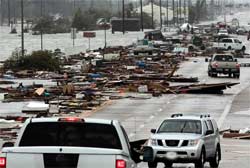ALBUQUERQUE, N.M. -- Rescuers on Wednesday pulled a Texas family from an SUV that had been buried in a snowdrift on a rural New Mexico highway for nearly two days.
State police said rescuers had to dig through 4 feet of ice and snow to free the Higgins family, whose red GMC Yukon got stuck on U.S. 56 near Springer when a blizzard moved through the area Monday.
Rescuers found David and Yvonne Higgins and their 5-year-old daughter Hannah clinging to each other and lethargic early Wednesday morning. The family is recovering at Miners Colfax Medical Center in Raton.
David Higgins told The Associated Press he and his wife both have pneumonia but his daughter is fine. He said he was glad to be able to talk about his ordeal because he had feared that he and his family might not be found.
"By 9 or 10 Monday night, I realized there was solid snow outside my window. I tried to shove my arm through the top of the window. I thought it can't be that deep," the 48-year-old father said. "I pushed as hard as I could. My arm went about 16 inches and there was still snow."
The family, who had left their home near League City, Texas, on Sunday for a ski trip at Angel Fire in northern New Mexico, started to hit bad weather soon after they crossed the state line into New Mexico on Monday afternoon.
They had checked road conditions. Difficult driving was reported but the road was still open. They followed a snowplow for a while, but visibility dropped to zero.
"It was white. You couldn't even see the yellow line," David said.
It was getting so bad that he had slowed to about 5 mph.
"You're thinking there are these people from Colorado and New Mexico behind us going, `Those Texas drivers, they don't know how to drive in this snow,'" he said. "Then I'm thinking to myself, `How can they drive in this?' You can't even see."
Despite having snow tires on their SUV, the snow stopped the family in their tracks. David Higgins tried backing up and then driving forward again. He made some progress but then the back end slipped around and the vehicle started to slide down an embankment.
He was able to keep the car running for a couple of hours, but when he went to get out to clear the exhaust pipe, his door was blocked.
Early on, the family could hear vehicles passing, so they tried honking the horn. That didn't work.
The Higginses had their ski gear, plenty of water to drink, sandwiches, chips and Chex mix. But as the hours passed, it seems as if they were working harder to breathe inside the buried SUV.
"We weren't sure of it, but we think we were running out of air. That was spooky," he said.
Higgins was able to reach his brother in Texas by cellphone and let him know the family's general location. The distress call was relayed to state police, which launched a search for the family Tuesday evening.
The National Guard was called out, along with state transportation workers. State highway trucks with plows and rescuers in four-wheel-drive vehicles pushed through heavy snow and drifts as high as 10 feet as teams probed the snow looking for the family's SUV.
One of the rescuers hit the hood, and the digging started.
Higgins said rescuers had to break the window to get to him and his family.
"They pulled us up and out of it," he said. "The rescuer took pictures and it looked like a rabbit hole. We were 3 to 4 feet above the vehicle."
The Higginses were among 32 vehicles state police and guardsmen rescued from the storm, but they were the only ones who police say needed medical attention.
"Tired and whooped" is how Higgins described his family after their ordeal.
They had a steady stream of visitors at the hospital Wednesday as state police officers and rescue workers came to check on them.
Higgins' parents were on their way to New Mexico on Wednesday night to help the couple. Whether they would make it home in time for Christmas was still unclear, since Higgins said his wife still wasn't feeling up to a long trip.
He was able to joke that a ski vacation was definitely out this year, but he wouldn't mind taking his family on a cross-country trip next summer – when there's no chance of it snowing. He said his daughter loves to go camping and there are plenty of places he and his wife have yet to see.
Playing games on their cellphones and watching movies on his daughter's travel DVD player helped pass the time, but Higgins admits the thought of not making it out alive started to cross his mind after a day of being buried.
"We didn't realize how deep the snow was," he said.
Higgins had a simple message for travelers this winter: Throw a case of water and a sleeping bag in the car.
"It will be there if you need it," he said. "I could see if we weren't half as prepared as we were, it could have been a worse outcome." (HuffingtonPost.com)
 Your Evacuation plan should take into account the following things:
Your Evacuation plan should take into account the following things: